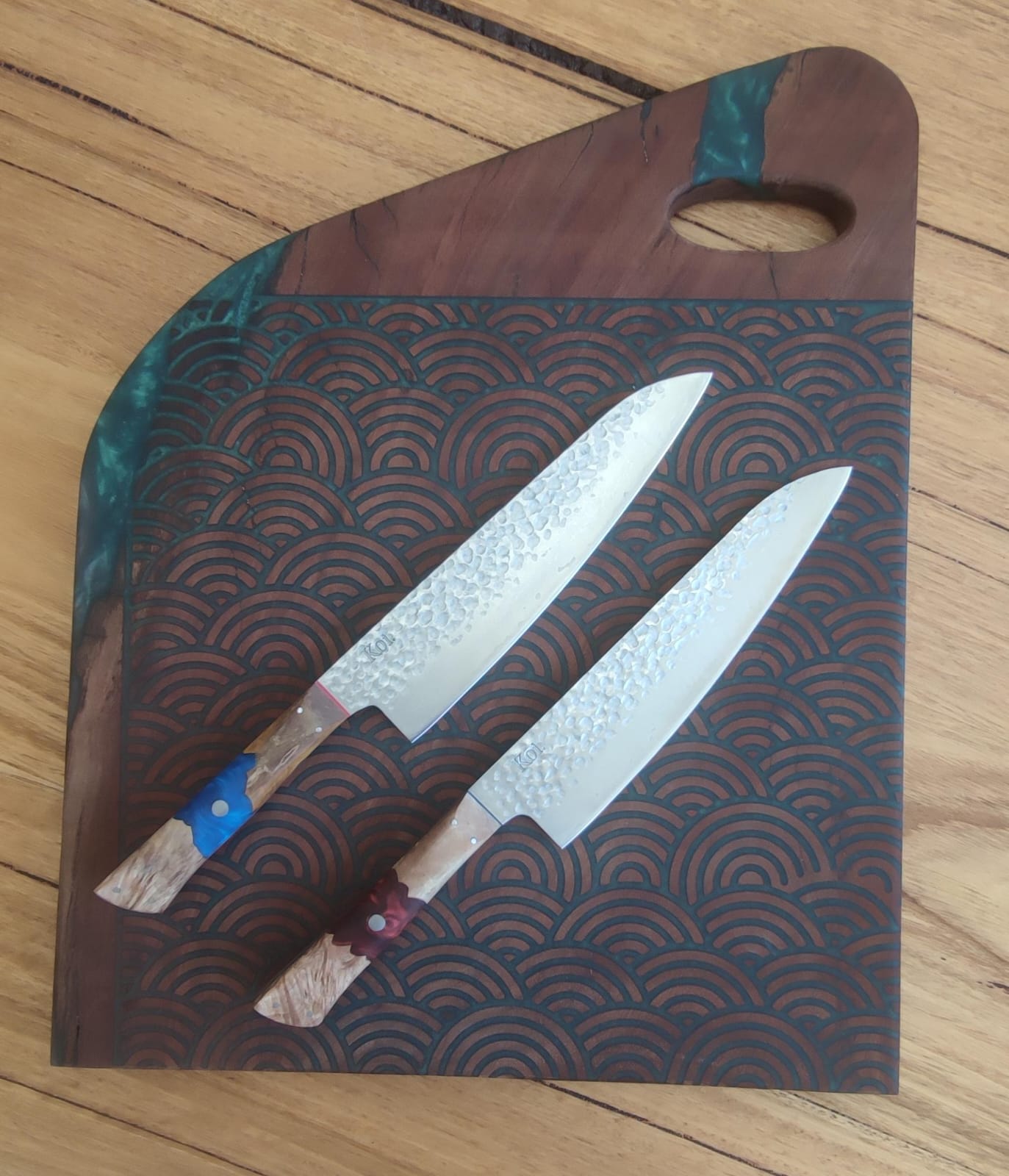The patina on your knife not only looks stunning but also serves as protection. Knives made of high carbon steel will tarnish with time. The fact that they document the delicious meals they prepare is an integral element of their personality and beauty. The layering of a patina is a fascinating experience that may bring you closer to your knife and the food you make. For someone used to a stainless steel knife, it can first be a bit of a shock.
When the Japanese evaluate a blade's "excellent sharpness," they primarily refer to a blade that cuts food without altering its cellular structure. The knife must be made of steel with particles that are as fine and uniform as possible to achieve such a fine edge. Due to the steel's microstructure, it is possible to sharpen a blade to a thin, smooth edge that will cut through cells without tearing them.
In order to provide a lesser sharpening angle, the steel must have a hardness of 60 HRC or higher. These characteristics are most frequently found in carbon steels, which have a very high carbide content and, as a result, a low chromium level. But compared to knives made of stainless steel, which are more prevalent, a carbon steel blade behaves slightly differently.
Carbon steel blades tarnish with usage and time. The knife is most delicate when it is brand-new and has not yet acquired a patina that will later preserve it and increase its durability.
How Can You Identify a Patina?
Oxidation, weathering, or combining the two can lead to patina. When a Japanese knife is exposed to weathering agents like water, wind, ice, severe temperatures, or other causes, oxidation occurs, eventually tarnishing the substance's coat or surface. Additionally, a patina can develop due to ageing, wear, or buffing.
Materials develop a patina to stave off corrosion damage but can also be employed for aesthetic looks. A knife patina can be identified by its distinctive colours, which emerge as golden yellow and progress to deep blue, purple, and grey, which darkens through time. If you discover red rust dots, you should clean them up.
Patina vs. Rust
The surface of oxidized steel develops a thin layer called a patina that shields it from more oxidation.
Rust is a thicker, typically brown iron oxide deposit with a reddish tint that forms when iron and oxygen combine with water or moisture in the air. The blade is not protected by rust, instead accelerating the deterioration where it first appeared. Before using the knife, clean off any rust you may have noticed on the blade.
Knives made of carbon steel need more care than those made of stainless steel since they can oxidize in two different ways. Rust, also known as hematite, is aggressive oxidation that destroys the metal and leaves behind a crusty, orange surface. Magnetite is a moderate oxidation that only damages the metal's exterior surface, and its presence inhibits further corrosion.
Which Steels Get a Patina and Which Are the Most Susceptible?
Steel comes in three varieties: powdered steel, stainless steel, and carbon steel.
· Carbon Steel
As the name implies, carbon steel primarily consists of carbon and contains little to no chromium. Japan's most widely used carbon steels are SUJ2, SKS93, white steel (Shirogami/White Paper Steel), and blue steel (Aogami/Blue Paper Steel). Shirogami is the most susceptible of the three since it lacks chromium and builds a patina fast.
Shirogami steel knives need a little more maintenance and are only for seasoned users. Although SUJ2 steel is less delicate than white steel, it rapidly develops a patina. Aogami, carbon steel that can include up to 1.5% chromium, is the least sensitive type. An example of a carbon steel knife is the classic single-bevel Japanese knives famed for their razor edge and delicate details. Single-bevel knives need to be incredibly sharp, and carbon steels are the only material that can get to that sharpness level.
· Stainless Steel
Chromium, present in stainless steel in amounts greater than 12%, interacts with oxygen to generate a passive layer that shields the steel from corrosion attacks. One of the most popular and respected Japanese stainless steels for the production of cutlery is VG-10 steel. It offers excellent edge retention and sharpness. Often carbon steel knives have a cladding layer of stainless steel to protect the blade surface from corrosion, although the cutting edge will still be prone to rust.
· Powder steels
Powder steels are unique in that certain alloys include enough chromium to be considered stainless, while others have less chromium and are prone to tarnishing.
How to Patina a Knife Blade
At first glance, forcing a patina onto a knife blade can seem absurd. After all, the knives are polished and finished for numerous hours by expert knifemakers to provide the greatest possible appearance. Patinas, however, can also give a knife blade a distinctive look and preserve it from oxidation.
Carbon steel will develop slight discolouration on some plants and acidic dishes, such as onions or pineapple, until the patina has fully grown. While cutting acidic foods, rinse the blade often, especially until the patina has fully developed. Compared to a knife used chiefly for cutting vegetables, a knife used primarily for cutting meat has a thin, almost translucent tint.
A patina won't need to be "forced" because it will develop naturally with time, but if you want to hasten the process or design your unique patterns, here's how to achieve it.
When a more consistent finish is desired, a forced patina made of vinegar or instant coffee is suggested (fresh coffee contains too much oil). Mustard patinas offer additional alternatives for more original designs.
What You’ll Need:
- Carbon steel/ semi-stainless steel knife blade
- Denatured alcohol, acetone, or Windex
- Vodka-based vinegar (any type)
- Kitchen towels made of paper
- Spray bottle
- Measure the length of your blade or knife.
Methods
It is crucial to carefully clean your blade, to ensure that the vinegar contacts the whole surface. You can use baking soda and water paste to remove any patina that has already formed on the blade.
- Apply the vinegar equally on both sides of the blade using the paper towel. Allow the vinegar to rest for about 5 to 10 minutes, then wash it off with water and hand dry. Reapply as required to achieve an even-ish colour.
- Cover the blade in kitchen paper after first soaking it in vinegar. The blade is left with an intriguing mottled pattern as a result.
- If you have a large enough container, you may fill it with vinegar and immerse the blade without wetting the handle. The blade starts to discolour and develops tiny bubbles. This procedure is sometimes called vinegar etching.
- Point the blade down into the vinegar-filled container, dip it, and pull it out. Permit the vinegar to drip off the handle and down the blade.
- Fill a spray bottle halfway with vinegar and spritz softly above the blade, allowing the droplets to fall and land on the blade's surface.
Noteworthy Details
- The patina will form more quickly if the vinegar is warmed.
- You may also use yellow mustard, tomato sauce, and mayonnaise since they are simpler to "brush" on while making designs.
- The vinegar should not be allowed to dry on the knife as it may cause rust stains. After a few minutes, rinse it off and dry the blade.
- Any sections of your blade that currently have a patina will get much darker with time.
Conclusion
A patina aids in the prevention of rust formation on a carbon blade. Even though rust and patina are both types of oxidation, rust will eat away at the edge and harm the metal, but a patina will provide a kind of completed seal that can stop corrosion and further rust damage.




